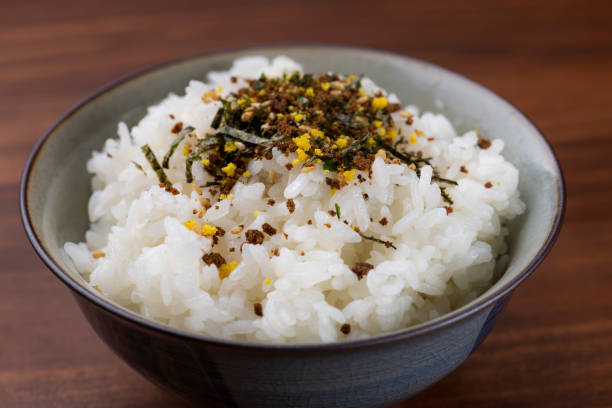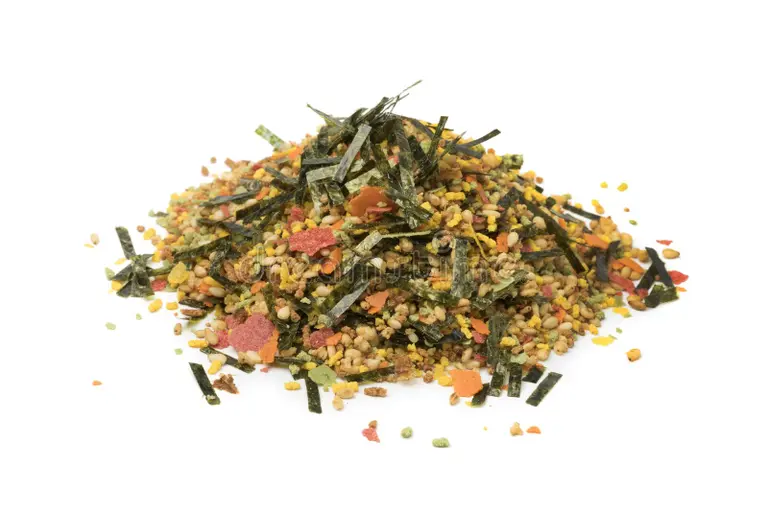|
Listen to article
Getting your Trinity Audio player ready...
|
In this post we’ll answer your query “Does furikake have gluten?” and discuss an easy furikake recipe for you to try. Discover the flavorful appeal of furikake, a popular Japanese rice spice that goes beyond its traditional use to become a flexible dry condiment that goes well with a wide range of foods. Dried seaweed, sesame seeds, honey, and salt are among its alluring component combinations, which come together to create a symphony of mouthwatering umami flavours. It adds an incredible flavour to stir fries and vegetarian grain bowls and is ideal for sprinkling on top!
Not only can spice blends lose their freshness beyond their expiration date. (Consider Italian seasoning: it works well in a lot of dishes, but using it all the time can make it less appealing). To stimulate your taste buds, you may occasionally require something novel. Enters furikake, a concoction of sugar, salt, sugar-coated dry seaweed flakes, and occasionally bonito (fish) flakes. It may also be seasoned with various flavourings like as wasabi, mirin, or soy sauce.

Contents
What is Furikake?
A variety of Japanese meals benefit from the umami, salty, and crunch that furikake, a rice seasoning combination, brings to the table. Furikake can be made in a variety of methods, although most call for combining nori seaweed and sesame seeds. It may even be good for your health, but this spice has a deep, savoury umami flavour, despite its appearance as simple fish meal.
For bland dishes like white rice, it works wonders. It can also improve your roasted salmon with just a light dusting before baking (neither lemon juice nor salt needed). What’s amazing, though, is that it’s a great method to boost your diet’s calcium content as well as other nutrients. This is a seasoning combo you should try if you haven’t previously seen it in the spice area of your neighbourhood supermarket.
You may also find soy sauce, chilli flakes, fish flakes (bonito flakes), and other tasty additions. The components for this wildly popular Japanese condiment are easily found at neighbourhood Asian grocery stores, and it’s quite simple to create at home!
Does Furikake Have Gluten?
Sure, a few furikake goods are devoid of gluten.
Seaweed and sesame seeds are combined to make furikake, a salty-sweet Japanese condiment. Numerous brands provide furikake that is gluten-free, such as:
- Pacific Harvest: Seasonings free of artificial components, gluten-free and vegan
- Veggiekinsblog: A straightforward recipe made using a food processor and no gluten or dairy
- Fulamingo Japanese Sake & Grocery: Furikake made with nori, white and black sesame seeds is gluten-free, vegan, and soy-free at Fulamingo Japanese Sake & Grocery.
- Furikake Co: Made with naturally gluten-free Nori Komi, furikake is devoid of gluten. Nori Goma is a gluten-free, salt and MSG-free furikake rice seasoning
Now that you know the answer to the question “Does furikake have gluten?” let’s ;earn a simple furikake recipe

What Makes This Furikake Recipe Great
This furikake recipe is perfect for you if you enjoy flavour, crunch, and texture! Delicious spice can be made at home and used on a variety of foods, including stir-fries, sushi rolls, soups, stir-fried veggies, and salads. It’s savoury taste goes well with so many different kinds of cuisine. It’s also a lot less expensive and easier to produce than other store-bought furikake seasoning.
Ingredient Notes
You’ll need a few basic ingredients to make this furikake recipe simple, fish-free version of furikake at home. These can be found at specialised food stores or Asian markets in your area.
- Seaweed: Select untoasted, unsalted nori sheets.
- Tamari: Soy sauce without gluten also works well! If you’re not gluten-free, use ordinary soy sauce instead.
- Sesame oil: Toasted sesame oil has the richest flavour, in my opinion.
- Mirin: This gives the mixture a touch of sweetness and acidity.
- Cane sugar: If you’d like, you can also use organic cane sugar.
- Togarashi: You may get this Japanese seasoning at well-stocked grocery stores like Whole Foods and nearby Asian markets.
- Powdered shiitake mushrooms: Furikake gains a tonne of umami from the shiitake mushrooms!
- Add the white and black sesame seeds for colour and nuttiness.
Furikake Recipe Instruction
After assembling your supplies, preparing this traditional Japanese seasoning combination is a breeze. A high-speed blender or food processor is required.
- Set oven temperature to 250 degrees Fahrenheit.
- Gather ingredients for the tamari, sesame oil, mirin, coconut sugar powder, mushroom powder, and togarashi in a big bowl.
- Next, add your nori sheets to the dish after using your hands to shred them into little pieces. Try to coat as many pieces of nori as you can by massaging the seaweed into it. The seaweed should be slightly moist but not drenched.
- Finally, add the togarashi and sesame seeds to the dish and stir with your hands once more. As much as you can, spread the seaweed mixture on a baking sheet covered with parchment paper.
- Bake for 5 minutes at a time, stirring after each 5 minutes. Continue for three more times, or until the seaweed is nicely roasted and completely dry.
- Before proceeding to the following step, allow it to cool completely.
- After the seaweed combination dries, put it in a food processor and pulse it until the pieces are small. It should have the texture of dry parsley; if you like your food chunkier, go ahead and leave it that way! You want it to be fine enough to blend easily into rice.
- Keep in a dry location, such as your pantry or spice cabinet, in an airtight container.
Check out this delicious recipe Japanese rice with furikake.
How to Store Furikake
To make your own furikake, chill the mixture and then pour it into an airtight container or glass jar with a cover. Keep it in the refrigerator to keep moisture out. Store store-bought furikake in the refrigerator or out of direct sunlight after opening the packaging and resealing or carefully closing it.
Ways to Use Furikake
- Drizzle over a rice bowl. We now know exactly how to prepare brown rice in your Instant Pot!
- Use it as a popcorn seasoning.
- Put it in a poke bowl (a grain and vegetable bowl).
- Before serving, roll the vegetarian sushi rolls in it.
- Add to stir-fries.
- Add to bowls of ramen noodles.
- On top of avocado toast, sprinkle
Furikake can also be excellently added to party mix, potatoes, salads, udon pasta dishes, rice porridge, and any other cuisine you can think of. Furikake is easy to produce in large quantities and is a delightful present to give to friends.

How to Use Furikake
Furikake is a spice that’s used in Japan to season onigiri and sprinkle over rice. Furikake is a spice that is sometimes added to poke, a raw fish dish from Hawaii.
Furikake is a versatile ingredient that you may experiment with at home by adding a dash of crunchy-chewy texture or a savoury, nutty flavour wherever you’d like. Try sprinkling furikake on popcorn, pan-seared salmon, roasted veggies, ramen, and grain bowls. Try creating Fried Rice Paper with Furikake (shown above), which is heavily dusted with furikake, for a simple, quick, and crispy snack.
Will furikake turn toxic? Yes, eventually, despite the dryness of the components. Furikake can be used past its expiration date, just like any other seasoning or food item, according to Chef Gourmet. It may therefore lose its effectiveness. Therefore, after opening your furikake, make sure to check the expiration date and refrigerate it. It can be stored in the refrigerator for up to one month. Additionally, check the label for the product’s expiration date as shelf life differs throughout brands. Granted, a sealed bottle in your cupboard could last for several months. But when you can give your dish such amazing flavour, why let it gather dust?
It is advisable to eat furikake within two to three days if you plan to make your own. Additionally, you may freeze your handmade furikake for up to three weeks if you’d want it to last longer. you ensure it doesn’t get lost among all the food you stuff in your fridge or freezer, make sure you label it and place it in a noticeable spot.

Conclusion
Furikake is a flavorful Japanese sauce that is commonly used on rice, seafood, and vegetables. Furikake comes in a wide variety of forms, but common combinations include dried nori (seaweed), toasted sesame seeds, dried fish, dried egg, dry herbs, salt, and sugar. Hopefully, this post has answered your query “Does furikake have gluten?” You can try the simple furikake recipe at home.
You can also check other posts:
Does Peroni have Gluten? 3 Popular Gluten-Free Beer Brands


